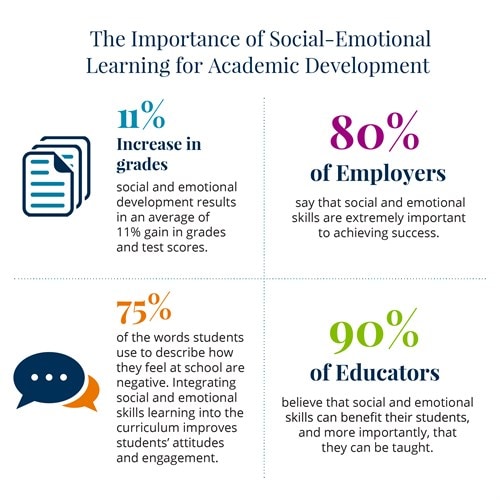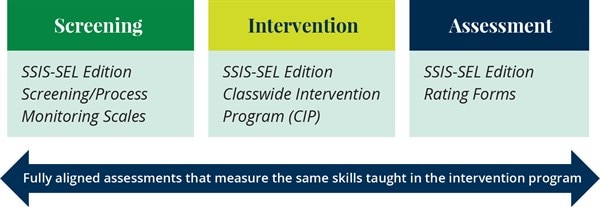Social & emotional learning: five key skills you can start teaching in your school
Research is increasingly telling us that children and adolescents who learn social and emotional (SEL) skills achieve better academic development, physical health, and quality of life. 90 percent of educators believe that SEL skills directly benefit their students’ performance, and 80 percent of employers believe that SEL skills are extremely important to achieving success in the workplace.
Learn about the five key skills you can start teaching, and how to implement an effective classroom system in your school.
What is SEL?
SEL is the process through which students acquire the knowledge and skills to understand and manage emotions, set and achieve positive goals, empathise with others, cultivate positive relationships, and make responsible decisions. It provides a foundation for safe and positive learning, and teaches students resilience and life skills. A recent meta-analysis revealed that adoption of SEL programs led to a 22 percent increase in social and emotional skills, and an 11 percent increase in academic achievement.
Separate studies have shown that having emotional and social skills can help increase the likelihood of high school graduation, readiness for postsecondary education, career success, positive relationships, and better mental health.

Setting students up for life: five key skills
If we expect students to be ready for life after school, then classroom instruction must include the following social and emotional skills: self-awareness, self-management, social awareness, relationship skills, and responsible decision-making.
Each social and emotional skill is listed in more detail below, along with an example of how it can be promoted in the classroom.
|
|
Self-awareness: |
Reflective tasks like journaling allow students to see their impact on the world. |
Self-management: |
Breathing exercises, taking a break, and counting to five are tools that can help a student deal with strong emotions or learning anxiety. |
Social awareness: |
Role-play a social justice issue, or conflicts that arise in the playground, like bullying. |
Relationship skills: |
Project-based group work can help students learn to compromise and work cooperatively together. |
| Responsible decision-making: the capacity to consider the wellbeing of self and others, and ability to evaluate the consequences of various behaviours and actions. |
Ask students to debate an issue, or make pros and cons lists to help them listen to, and respect, others’ ideas. |
The importance of Response to Intervention (RTI)
RTI is a multi-tiered framework that can help identify students with learning difficulties and provide evidence‐based early intervention. A student's response to instruction and intervention allows you to recognise which tier and level of intervention is appropriate for the student. Students in tier 1 and 2 respond well to general classroom instruction, and may only need smaller group intervention to help them catch up to their peers.

RTI also aims to identify the students in tier 3, usually 5% of the class, who are struggling the most as they lag behind their peers by more than 12 months. Students in this tier usually go through tier 1 and 2 without making major progress, and will therefore require a referral to an allied health professional for intensive, individualised intervention.
This framework can also be used to identify students who have social, emotional, or behavioural difficulties, as well as academic difficulties. In this way, the RTI model can be helpful for improving learning of academic skills and social and emotional skills.
The Social Skills Improvement System – Social-Emotional Learning (SSIS-SEL) Edition
The good news is that social emotional learning skills can be taught and continuously improved using in-class assessment and intervention tool like SSIS-SEL. This assessment is based on the RTI model and provides evidence-based tools to screen, assess, and intervene for each of the five key emotional skills. The program can be used as a preventative framework for students who present minor to mid-range difficulties in tiers 1 and 2, and it can also be applied as a more comprehensive intervention tool for struggling students in tier 3. SSIS-SEL is a flexible clinical tool, it can be applied either as a classwide program, or as a targeted solution in smaller groups of students.
SSIS-SEL is the only system that incorporates key academic skill areas, allowing you to assess the same skills that you teach. Using this system, you can support the development of social and emotional skills in each of your students.
The screening assessment takes approximately 5 to 10 minutes to complete, the full assessment takes approximately 15 to 20 minutes to complete, and the intervention modules take up to half an hour to complete.

This article is part of the Mind the Gap initiative, aimed at supporting student wellbeing to improve learning outcomes. For more information about supporting your special education or classroom teachers with effective assessment tools like SSIS-SEL, please feel free to contact Anisa Zulfiqar.

